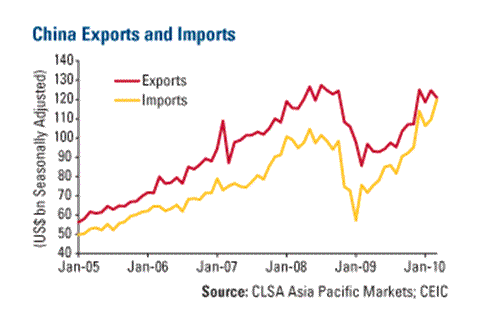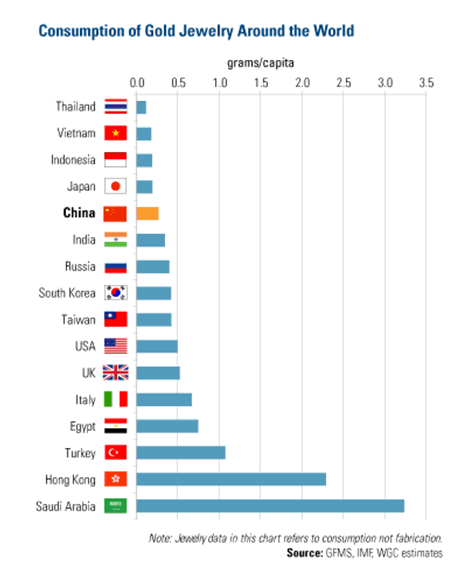China Imports Boom
Economics / China Economy Apr 26, 2010 - 01:53 PM GMTBy: Frank_Holmes
 Just as the U.S. consumer is key for Chinese exporters, so too is the Chinese consumer key as an export destination for the rest of emerging Asia.
Just as the U.S. consumer is key for Chinese exporters, so too is the Chinese consumer key as an export destination for the rest of emerging Asia.
A research note this week from the Hong Kong-based brokerage CLSA Asia Markets spells out how important the Chinese consumer was in pulling its neighbors up and out of the Great Recession. Many of these countries have more than doubled their exports to China since the depths of the recession in late 2008 and early 2009. Exports from technology-oriented Taiwan to the mainland, for example, are up more than 160 percent from the bottom, while Singapore has boosted its exports to China by more than 120 percent and South Korea by nearly 100 percent.
Those are relative numbers – how important is China to its neighbors in absolute terms? Nearly 30 percent of Taiwan’s total exports, accounting for 15 percent of its GDP, now go to the mainland. A quarter of South Korea’s exports (10 percent of GDP) are China-bound. For both of these countries, and others as well, China is more than twice as important as the United States in terms of exports.
The visual below shows China’s current account trend lines – sharply rising imports intersecting with a slightly flagging export sector.

Now we’re not ready to dust off the D-word – “decoupling” – quite yet, but the regional trend is clear and it appears sustainable if for no other reason than an ever-richer China as the market hub of a dynamic regional economy makes both geographic and demographic sense.
Rapidly rising incomes in China are making its consumers look more and more like those in the developed world. They want nice clothes and the latest high-tech gadgets, and their desire for more spacious homes outfitted with modern conveniences is a primary driver of the nation’s housing market. Housing prices in Beijing and Shanghai may be getting a little ahead of themselves, but the government is taking prudent measures to slow things down in a measured and orderly fashion. The respected analysts at BCA Research see a frothy and vulnerable housing market, but they still say “Chinese consumer spending will remain robust.”
Another point worth mentioning – Beijing and Shanghai may be China’s most important cities, but the country and its economy is so much more, just as New York and Washington, D.C. don’t represent the entire United States. The central government is clearly serious about spreading the wealth now concentrated on China’s eastern coast deep into the nation’s interior.
The inland provinces and cities present a vast growth opportunity, and to seize that opportunity, the government is moving forward with a long list of high-speed “bullet train” projects, regional airports, new power plants and other infrastructure. This is the spade work that must be done before a vibrant economy can grow and flourish.
Income levels drop off as you move inland in China, but there’s a growing market in those areas for luxury goods. We pointed out a few weeks ago that high-end retailers like Gucci and Louis Vuitton are opening shops in the back country, which is a testament to increasing wealth levels.

Along with luxury goods, Chinese citizens with rising incomes and accumulations of wealth are likely to become bigger consumers of gold. China has a centuries-long cultural attraction to gold, but affordability has been an obstacle. Even at today’s high prices, the Chinese are in a good position to buy gold as jewelry or for investment purposes. They and other Asians (foremost Indians) see small price corrections as an opportunity to stock up.
The chart above shows where China stands on a per-capita basis among countries with a traditionally high affinity for gold. China’s currently near the bottom of the list but the World Gold Council believes per-capita gold consumption by the Chinese could easily double in the next decade. This, obviously, would have a massive impact on the global supply-demand balance.
As part of our investment process, we examine intermarket relationships to try to determine whether or not we believe they are sustainable. In the case of the Chinese consumer, we not only believe he is here to stay, but also that he will grow in influence both regionally and globally in the years ahead.
By Frank Holmes, CEO , U.S. Global Investors
Frank Holmes is CEO and chief investment officer at U.S. Global Investors , a Texas-based investment adviser that specializes in natural resources, emerging markets and global infrastructure. The company's 13 mutual funds include the Global Resources Fund (PSPFX) , Gold and Precious Metals Fund (USERX) and Global MegaTrends Fund (MEGAX) .
More timely commentary from Frank Holmes is available in his investment blog, “Frank Talk”: www.usfunds.com/franktalk .
Please consider carefully the fund's investment objectives, risks, charges and expenses. For this and other important information, obtain a fund prospectus by visiting www.usfunds.com or by calling 1-800-US-FUNDS (1-800-873-8637). Read it carefully before investing. Distributed by U.S. Global Brokerage, Inc.
All opinions expressed and data provided are subject to change without notice. Some of these opinions may not be appropriate to every investor. Gold funds may be susceptible to adverse economic, political or regulatory developments due to concentrating in a single theme. The price of gold is subject to substantial price fluctuations over short periods of time and may be affected by unpredicted international monetary and political policies. We suggest investing no more than 5% to 10% of your portfolio in gold or gold stocks. The following securities mentioned in the article were held by one or more of U.S. Global Investors family of funds as of 12-31-07 : streetTRACKS Gold Trust.
Frank Holmes Archive |
© 2005-2022 http://www.MarketOracle.co.uk - The Market Oracle is a FREE Daily Financial Markets Analysis & Forecasting online publication.



